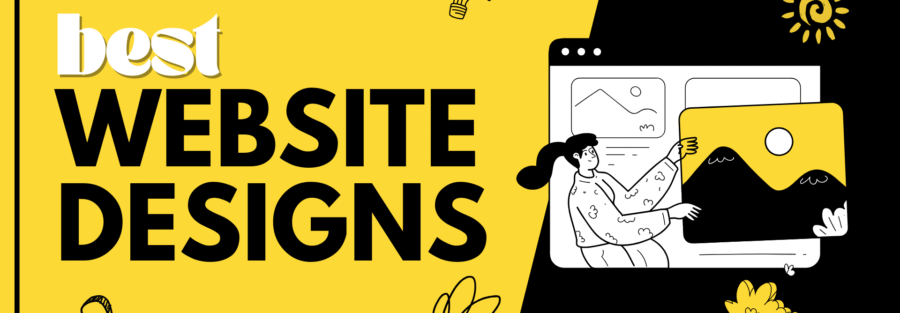The Best Website Designs: What Makes Them Stand Out
In today’s digital world, having a well-designed website is no longer optional — it’s essential. Whether you’re a small business, an e-commerce giant, or a personal brand, your website is often the first interaction potential customers will have with your brand. Therefore, a great website design can set you apart from your competitors and provide a seamless experience for visitors.
But what exactly makes a website design great? Let’s break down the key features and trends that define the best website designs


1. Minimalist Design: Simplicity with Purpose
One of the most timeless and effective website design trends is minimalism. A minimalist design focuses on simplicity, stripping away any unnecessary elements. By doing so, it allows for better navigation, improved readability, and more focus on what truly matters — your content.
What Makes It Great?
- Clean layout: Less clutter, more focus on the message.
- White space: Allows users to breathe and feel less overwhelmed.
- Clear CTAs (Calls-to-Action): Easy-to-find buttons that lead to conversions.
Example:
Apple – Apple’s website is a prime example of minimalist design. The homepage often features stunning visuals and simple product showcases with clear, easy-to-read text.
2. Mobile-First Design: Optimized for Every Device
In 2025, mobile-first design is no longer a trend — it’s a necessity. With more than half of web traffic now coming from mobile devices, designing your website for smaller screens first ensures that your site is accessible to the largest audience possible. A mobile-first approach involves designing a website that works seamlessly on smartphones, and then scaling it up for desktop.
What Makes It Great?
Example:
- Responsive layout: Automatically adjusts to fit any screen size.
- Touch-friendly: Large buttons and easily tappable areas.
- Fast loading: Essential for mobile users with varying internet speeds.
Example:
Amazon – Amazon’s mobile website is a masterpiece of mobile-first design, with easy navigation and fast checkout processes tailored for on-the-go shoppers.
3. Bold Typography: Making a Statement
Typography plays a key role in how your website communicates. Bold fonts and creative typography choices can set the tone of your brand and make your content more engaging. The best websites use typography that is not only visually striking but also readable.
What Makes It Great?
- Easy readability: Clear fonts that work well on all screen sizes.
- Visual hierarchy: Using different sizes and weights to guide the user through the content.
- Brand consistency: Custom fonts that match the brand’s identity.
Example:
The New York Times – Known for its bold typography, the newspaper’s website uses large, impactful fonts to convey important news stories and guide users to the content they care about.
4. Interactive Elements: Engaging the User
The best website designs go beyond static images and text — they include interactive elements that engage users and create a more dynamic experience. From hover effects to micro-interactions, these interactive features make the site feel alive and responsive.
What Makes It Great?
- Engagement: Interactive elements capture attention and keep users on your site.
- Fun interactions: Subtle animations or hover effects that delight users.
- Functional animations: Elements that provide feedback, like a button changing color when clicked.
Example:
- Nike – The Nike website uses interactive elements, such as hover effects and animations, to create a fluid and dynamic user experience, making shopping for sneakers and apparel more enjoyable.
5. Parallax Scrolling: Creating Depth and Movement
Parallax scrolling is a web design technique where the background content moves at a slower speed than the foreground content, creating an illusion of depth. This effect can make your website feel more immersive, telling a visual story as users scroll down the page.
What Makes It Great?
- Visual storytelling: Engages users and encourages them to keep scrolling.
- Adds depth: Creates a more dynamic, three-dimensional effect.
- Smooth transitions: Makes the site feel more interactive and fluid.
Example:
Airbnb – The Airbnb website uses parallax scrolling to create a dynamic experience, especially on destination pages where users can interact with and explore visuals of different vacation spots.
6. Custom Illustrations: Building a Unique Brand Identity
Custom illustrations and graphics allow websites to stand out with a unique visual identity that stock photos just can’t offer. Custom illustrations help to convey brand personality and make the website feel more human and approachable.
What Makes It Great?
- Branding: Custom illustrations help convey a brand’s personality and message.
- Creative appeal: Illustrations provide a distinct visual style that sets the website apart.
- Playfulness: Adds a fun and unique touch to the user experience.
Example:
Mailchimp – Mailchimp’s website is full of playful illustrations that complement its branding. The fun, quirky visuals create a friendly atmosphere and help the website feel less corporate.
7. Fast Loading Speed: Keeping It Efficient
No matter how beautiful a website is, if it takes too long to load, users will quickly bounce. The best websites are optimized for speed, ensuring that users can access content quickly and without frustration. A fast-loading website not only provides a better experience but also improves SEO.
What Makes It Great?
- Fast loading times: Websites that load in under 3 seconds provide a smoother user experience.
- Optimized images: Compressed images that don’t sacrifice quality.
- Efficient coding: Clean, streamlined code that reduces unnecessary load times.
Example:
Google – Google’s website is incredibly fast, thanks to minimal design elements and optimized loading speed. This efficiency makes it a go-to tool for millions of users.
8. Visual Hierarchy: Guiding the User’s Journey
Great websites use visual hierarchy to direct users to the most important content and calls-to-action (CTAs). By using color, size, and spacing effectively, a website can guide the visitor’s journey seamlessly and make navigation intuitive.
What Makes It Great?
- Clear CTAs: Buttons and links that stand out, guiding users where you want them to go.
- Logical flow: Content arranged in a way that naturally leads users through the site.
- Contrast: Key messages and actions are highlighted through design choices.
Example:
Dropbox – Dropbox uses visual hierarchy to guide users to its main CTAs, like signing up or downloading, with large, clear buttons and compelling headlines.
Conclusion: The Best Website Designs Are User-Centric
In conclusion, the best website designs are those that not only look aesthetically pleasing but also offer superior user experience (UX). Whether it’s through minimalism, bold typography, interactive elements, or fast loading speeds, your website must be both functional and beautiful.
If you’re looking to design a website that makes an impact, it’s essential to choose a creative agency that understands design trends, user behavior, and SEO optimization. At SSF Designs, we specialize in creating custom websites that are not only visually stunning but also optimized for performance. If you’re ready to take your web presence to the next level, we’re here to help. DM +91-8700292865




